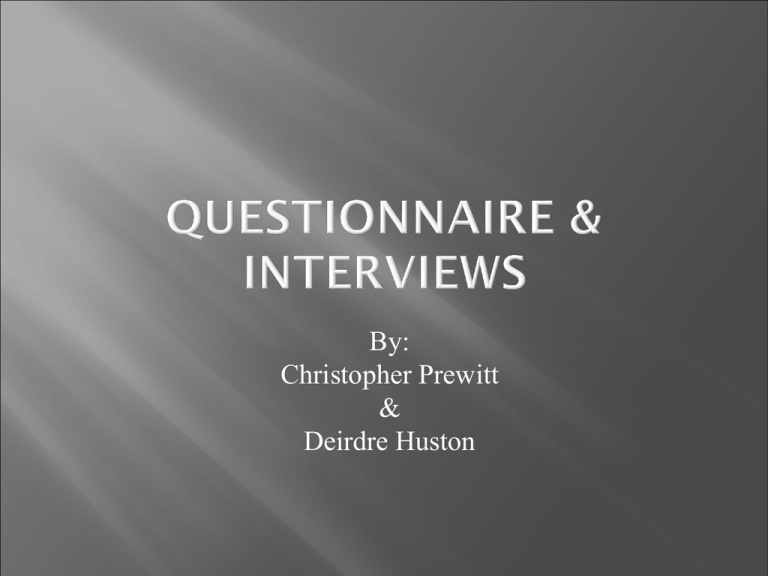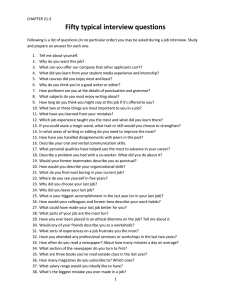Questionnaires & Interviews
advertisement

By: Christopher Prewitt & Deirdre Huston When doing any project it is important to know as much information about the project and the views of everyone involved with it so that the best direction for the project can be made. Two ways of gathering important information is through questionnaires and interviews. They both have positive and negatives but overall get the job done in different ways. Define goals and Objectives Determine Sampling group Create the Questionnaire or setup interview format Administer the questionnaire or perform interview Analyze the data The first step to doing research is to define your goals and objectives. What Type of Data are you gathering? What Do You plan to do with the data? What are the areas that your willing to explore? Are there any arrangements you must make to carry out your research? What Methods will you use in your research? Are your research process feasible? Random – Everyone has a equal chance of being selected. Systematic – Subjects are chosen in a specific order from a population Stratified – Selecting the subjects based categories Cluster – Samples are found from natural groups in a population Multi-Stage - Combining multiple sampling methods Convenience – no structure, surveying based on opportunity Quota - selecting participants based on a specific proportioned mutually-exclusive sub-groups of a population. Purposive - A specific sample of the population is targeted When selecting participants its important to select from groups that are involved with the project and are interested in it. It is also important to try to select from a variety of different groups within the organization. Incentives – Gifts for participants to entice them the complete the survey or participate in interview. The use of questionnaires is an indirect method of research used to gather a wide-range of information from a large population. Questionnaires are designed so that the participant must read the questions that they are being asked and must then answer them based on the response style. Contingency – A question that only applies to people who responded in a certain way to another question If yes complete this section if no, move to next section Matrix - A series of questions that’s share answer choices Scaled - Responses are graded on a continuum How important do you think standardized test scores are to a fifth grader’s Open Ended – Questions that the respondent can write their own answer. Unstructured – Randomly Generated Questions What do you like to do on your spare time? Word Association – Participant chooses the first word that comes to mind based on the list of words presented. Completion – Finish a story, sentence or picture that has already been started. One of the hardest task to do on my job is _________. Closed Ended – Questions with a list of options to choose from. Dichotomous – Questions with two possible responses (Yes or No) or (True or False) Do you know your weight ? Multiple Choice – Questions with several options to choose from Why don’t you use the school ‘s cafeteria services? It’s too expensive Severing times conflict with my class schedule The location is inconvenient The food quality is poor Objective data are questions that are not influenced by personal preferences and beliefs. Are you an MIS major? Subjective data are questions that are heavily influenced on personal preferences and beliefs. Do you like BA 3810? Quantitative data is numerical based data that is counted then analyzed Qualitative data is more precise data that contains words, pictures or objects. In the majority of research, qualitative data is preferred and has shown to provide more accurate answers than quantitative data. Clarity – Try to make the questions as clear as possible and not heavily based upon interpretation Wording of Questions – It is important to create questions that will give you the most precise answer that you want Avoid similar responses choices Do not include questions that will provide data that isn’t related to your goals & objective Add Open-Ended questions so that interested participants can further express their opinions Personal Handout Email Mail Web survey Scanning – Fills in their selected choice based on multiple options. Text Response – The participant creates their own personal answer It is a cost and time efficient way of collecting a variety of data from large populations Less pressure on the respondent to respond quickly or in a certain way They are easy to analyze and record the data Sampling Error – The margin of error Response Bias – The respondents answer’s are not their true beliefs Non-response Bias – Those who participate in a survey answer differently that those who don’t. Wording of Question – Sometimes the question is misunderstood because of wording. An interview is a direct method of research used to gather information for a specific purpose. In interviews, the interviewer has the capability to learn more about how participants feel about the questions based on their body movements. The interviewer can also clarify any misinterpretations of certain questions so that the answers will be more accurate. Structured – An organized interview with a specific list of questions and no interruptions from the interviewer. • Cognitive – Involves a series of methods used to figure out the process the participant goes through in a specific situation. Unstructured – A free-flowing interview with little organization and fewer questions. Personal – Interviewer and Interviewee are going through interview face-to-face Telephone – Conducting an interview via telephone Web Interview – Interviewing with e-mail, chat room or other form of communication over the web. Clarity – Speak clearly and properly so that the participant can understand you. Have a set list of questions that you would like to ask the participant and interact with them if necessary. Try to clock how long the interview will take so you don’t go overboard and run out of time. Try not to offend or throw off the participant with your questions and body motions. Responses are typically more detailed Interviewer can explain questions that are unclear Interviewer can observe the participants body language The Interviewer can add additional questions if they feel that the information will help their research. It can be difficult to get all the samples that you would like to because of high cost and amount of time needed. Courtesy Bias – the tendency for respondents to give answer that they think the interview wants to hear, rather than what they really feel Faulty memory – some respondents may answer a question incorrectly simply because of a poor memory When analyzing data it is important to note that your data will typically never be precise especially in large populations. There are statistical methods that can be use to get a more accurate measure of the data. Analyzing based on percentages of answers is often a common choice. Use the data to improve what is feasible in your project.





